Emily Dickinson's Interpretation to Solitude
Emily Dickinson

Dickinson wrote altogether 1775 poems, of which only 7 appeared in print in her lifetime. She didn’t like the “surgery” that some editors had done to her works. She belongs to the future.
themes
Dickinson’s poetry is a clear illustration of her religious-ethical and political-social ideas. Calvinism with its doctrine of predestination and its pessimism pressured her during her childhood and adolescence and colored her work so that her basic tone was tragic. She expressed a passionate yearning for religious certitude, God’s help, and the good life.
By far the largest portion of Dickinson’s poetry concerns death and immortality. Her preoccupation with these subjects amounted to an obsession so that about one third of her poems dwell on them.
Dickinson sees nature as both gaily benevolent and cruel. Her nature poems are great in number and rich in matter. Natural phenomena, changes of seasons, animals, birds and flowers of various kinds all found their way into her poetry. The grandeur of a sunrise, the mixed feelings of joy and grief at the coming of spring and autumn. In the meanwhile, the cold indifference of nature is also revealed in her poems.
(全英文论文)从《家有儿女》和《摩登家庭》看中美家庭教育差异
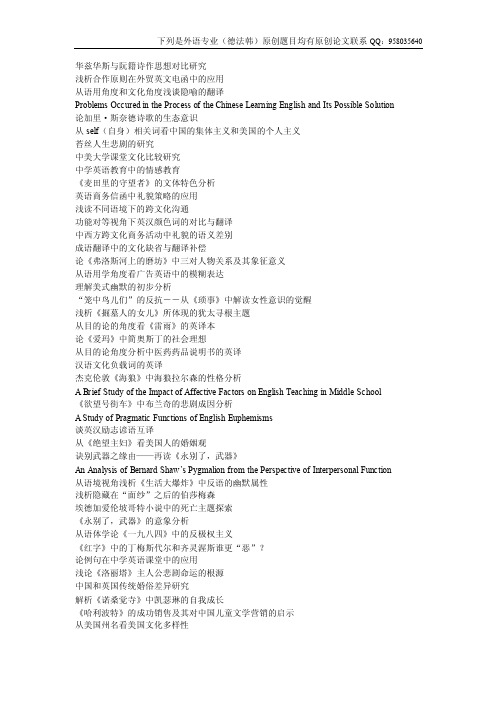
华兹华斯与阮籍诗作思想对比研究浅析合作原则在外贸英文电函中的应用从语用角度和文化角度浅谈隐喻的翻译Problems Occured in the Process of the Chinese Learning English and Its Possible Solution 论加里·斯奈德诗歌的生态意识从self(自身)相关词看中国的集体主义和美国的个人主义苔丝人生悲剧的研究中美大学课堂文化比较研究中学英语教育中的情感教育《麦田里的守望者》的文体特色分析英语商务信函中礼貌策略的应用浅读不同语境下的跨文化沟通功能对等视角下英汉颜色词的对比与翻译中西方跨文化商务活动中礼貌的语义差别成语翻译中的文化缺省与翻译补偿论《弗洛斯河上的磨坊》中三对人物关系及其象征意义从语用学角度看广告英语中的模糊表达理解美式幽默的初步分析“笼中鸟儿们”的反抗--从《琐事》中解读女性意识的觉醒浅析《掘墓人的女儿》所体现的犹太寻根主题从目的论的角度看《雷雨》的英译本论《爱玛》中简奥斯丁的社会理想从目的论角度分析中医药药品说明书的英译汉语文化负载词的英译杰克伦敦《海狼》中海狼拉尔森的性格分析A Brief Study of the Impact of Affective Factors on English Teaching in Middle School 《欲望号街车》中布兰奇的悲剧成因分析A Study of Pragmatic Functions of English Euphemisms谈英汉励志谚语互译从《绝望主妇》看美国人的婚姻观诀别武器之缘由——再读《永别了,武器》An Analysis of Bernard Shaw’s Pygmalion from the Perspective of Interpersonal Function 从语境视角浅析《生活大爆炸》中反语的幽默属性浅析隐藏在“面纱”之后的伯莎梅森埃德加爱伦坡哥特小说中的死亡主题探索《永别了,武器》的意象分析从语体学论《一九八四》中的反极权主义《红字》中的丁梅斯代尔和齐灵渥斯谁更“恶”?论例句在中学英语课堂中的应用浅论《洛丽塔》主人公悲剧命运的根源中国和英国传统婚俗差异研究解析《诺桑觉寺》中凯瑟琳的自我成长《哈利波特》的成功销售及其对中国儿童文学营销的启示从美国州名看美国文化多样性从《百舌鸟之死》探析美国种族冲突从目的论角度看公司网页误译浅谈文化差异对网络新词英译的影响二战后大萧条对美国社会福利的影响英汉诗歌中“月”意象的认知解读An Analysis of Fagin in Oliver TwistReconstruction of Black Identity in Toni Morrison’s BelovedA Comparative Analysis of English V ocabulary Teaching between China and America at the Primary and Secondary School Level从文化角度分析英汉数字习语的不同英语词汇中的性别歧视现象及回避方式动物习语翻译中的归化和异化跨文化背景下广告汉英翻译策略研究论小说《苔丝》中环境描写的作用从《在路上》看“垮掉的一代”Charlotte Bronte’s Concept of Marriage--Comment on Jane Eyre from angle of true love商务谈判策略研究On the Application of Polysystem Theory In the Two V ersions of HamletA Comparative Study on the Celebrations of Traditional Chinese and Western Festivals Symbolism in The Old Man and The Sea《红楼梦》杨霍两译本建筑名比较刍议美国情景喜剧中的美国俚语地理环境影响下的中英谚语差异合作学习在初中英语口语教学中的应用美国梦的幻灭——追问盖茨比命运的悲剧性根源从异化归化角度看汉语四字词组的英译策略—以中国苏州古典园林为例创世神话与民族特性—《旧约》与中国古代民间传说从概念隐喻看寓言的语篇连贯The Great Gatsby and the American Dream浅谈在华跨国公司的本土化策略从《献给艾米丽的玫瑰》看福克纳小说中贵族的没落从中西文化差异的角度浅析商宴之道The Death Image of Emily Dickinson’s Poetry浅析美国高等教育的创新西方电影片名翻译的功能目的论分析从女性主义视角解读《了不起的盖茨比》中的黛西从现代主义角度分析《月亮和六便士》英语会话中间接拒绝语的语用研究中美婚姻价值观对比德国功能目的论指导下广告口号的汉译《红字》中霍桑的女性观《永别了武器》悲剧特征的分析A Comparison of the English Color TermsOn the Conceptual Blending of Business English Word Chunks and Their Translation论海勒《第二十二条军规》小人物生存模式国际商务谈判技巧与策略初探目的论视角下的《边城》的英译研究英语基本味觉词“甜/苦”的隐喻机制A Cultural Approach to the Translation of Movie Titles浅析广告英语中修辞的魅力文化语境维度下中餐菜名的英译研究从《印度之行》看福斯特的人文主义思想观On C-E Translation of Neologisms from the Perspective of Nida’s Functional Equivalence Theory 英语旅游广告的文体分析浅析《老人与海》中桑提亚哥丰富的精神世界《宠儿》中黑人母亲角色的解读《马太福音》对话中语气的人际意义研究从用餐礼仪看中美核心价值观差异英汉社交称呼语礼貌规范和语用失误研究论《皮格马利翁》的结局A Comparison of the English Color Terms从礼貌原则看中英委婉语的差异从《盲人》中的“血性意识”看劳伦斯的文明观中西方婚礼文化差异不同的阅读任务对高中生英语词汇附带习得的影响法律语言浅析论乔治艾略特《弗洛斯河上的磨坊》中的环境描写从《老友记》看美国幽默教师身势语在英语口语教学中的应用探析《红字》中齐灵渥斯的恶中之善命中注定的悲剧--西奥多·赫曼·阿尔伯特·德莱赛《珍妮姑娘》的悲剧分析对小妇人心灵成长历程的探索快乐教学法在中学英语教学中的应用对意象翻译的初步研究英语谚语中关系分句之先行词he高频使用之探析浅析电影《阿甘正传》的语言特色解析《紫色》中妇女意识的形成词汇的语义关系及其在初中英语词汇教学中的运用尤多拉威尔蒂摄影叙事技巧分析浅谈英语习语的特点及其汉译伊恩麦克尤恩《时间中的孩子》中斯蒂芬的心理创伤和恢复分析On the Use of Satire and Humor in Pygmalion浅谈高中英语教师课堂提问与课堂互动初中英语教材知识体系建构的研究文化视角下的英汉委婉语翻译探讨《无名的裘德》主人公人物形象浅析The Essence of Love——An Interpretation of Persuasion简析译者文化背景对其处理习语翻译的影响--《水浒传》赛珍珠译本中的习语翻译目的论在电影字幕翻译中的应用——以《功夫熊猫》为例中美文化差异对商务谈判的影响英文电影对白中俚语的翻译On the Functions of Metaphor in Obama’s Inaugural Address英语委婉语及其翻译用会话含义理论分析《傲慢与偏见》中的人物对白文化差异对英汉翻译的影响战争隐喻在体育新闻报道中的运用从餐桌礼仪中的非语言交际角度看中英文化差异以“三美论”对比《登高》两个英译版本的“意美”与“音美”浪漫和现实冲突下的宿命论思想——赏析欧·亨利的《命运之路》中美电子商务的选择性分析A Discussion on the Accuracy of Language in Diplomatic TranslationA Comparison of the English Color Terms《玻璃动物园》中的逃避主义解读大学生英语口语学习策略研究论约翰多恩诗歌中的张力On Advertising Translation from the Perspective of Skopostheorie浅析隐藏在“面纱”之后的伯莎梅森论《飘》中思嘉丽的性格特征英语歌曲在英语教学中的应用论圣地亚哥性格的多重性及《老人与海》中的悲剧色彩任务型教学法在小学英语课堂的应用研究动机对中学英语学习的影响试比较《汤姆索亚历险记》与《哈克贝利芬历险记》中主人公性格异同点《玻璃动物园》中的逃避主义解读文化语境对隐喻理解的影响美剧网络字幕翻译研究《诗经》中修饰性叠词的比较研究归化和异化在汉语歇后语翻译中的应用浅析隐藏在“面纱”之后的伯莎梅森高中英语词汇教学中存在的问题及对策研究解析马克吐温《竞选州长》中的幽默讽刺艺术从合作原则浅析《飞屋环游记》中的言语幽默论《简爱》中伯莎梅森的疯癫汉语政治话语中的隐喻研究从功能对等理论看《好汉两个半》的幽默字幕翻译Jan e Austen’s Opinion towards Marriage in Pride and Prejudice分析《女勇士》中的女性形象儿童英语游戏教学The Gothic Beauty and Spiritual Essence of Allan Poe’s Short Stories冰山原则在《老人与海》中的体现评爱伦坡哥特式小说中的恐怖美宗教在世界战争史中扮演的角色关联理论视角下幽默的英汉翻译A Contrastive Study on the Cultural Differences between Chinese and Western Wedding Customs 目的论指导下的旅游资料汉英翻译及翻译策略英汉鸟类词汇文化内涵比较Human Nature and Redemption——Thoughts on Reading The Kite Runner相同之爱,不同诠释——从美剧《吉尔莫女孩》看东西方母女关系之异同《愤怒的葡萄》中圣经的象征和隐喻《宠儿》中黑人男性角色与黑人男性身份构建之关系浅析跨文化交际中的语用失误图式在英语阅读中的作用通过象征主义、梭罗的自然思想和梭罗的个人主义析《瓦尔登湖》王尔德童话中的毁灭与拯救对公共演讲课堂中大学生课堂表现的心理分析跨文化交际意识与中文旅游文本翻译《小镇畸人》中的空间形式分析从数字看中西方文化差异浅析习语翻译中的语用失误伏尼契小说《牛虻》中主人公性格分析A Study on Fuzziness of Advertising Language探讨宗教在世界战争史中所扮演的角色《远大前程》中社会环境对皮普的意识与行为的影响Analysis of Advertisements Based on the Cooperative Principle。
美国文学艾米莉狄金森资料

美国女诗人艾米莉*狄金森创作了大量关于自然的诗歌.她以深刻的洞察力和创造性的天赋为我们展示了她眼中的自然:隐含宗教色彩的自然、体现先验主义的自然、富于形象和意象的自然.美国女诗人埃米丽·迪金森的自然观与她的社会、家庭以及个人阅历有着极其密切的联系。
她诗歌中所描绘的自然既反映出爱默生的超验主义思想,又不时地唱出与清教主义旋律相近的曲调。
她热爱大自然,但又夹杂着疑惑和恐惧。
她的复杂的心理因素构成了她的复杂的自然观。
爱默生和梭罗所奉行的超验主义自然观无法完全解释艾米莉·狄金森内心深处对"自然之谜"的疑惑,因她有意识地在诗歌创作中进行了极富独创精神的"再定义":"自然"等同于"知识",为直觉或"超灵"难以洞悉;"自然"独立于人的意志之外,它对人的基本利益漠不关心,两者之间的疏离感无法打破.因为不能体悟"自然"的本质,诗人对"自然"的敬畏感逐渐加深,也构成了她对超验主义自然观冷静的质疑.狄金森和爱默生都相信读者应该经由个人的实践去感受和解读"自然之谜",而两者之间最根本的不同在于狄金森最终确定该命题无解.爱默生的超验主义思想为艾米莉@狄金森的的诗歌创作提供了无尽的源泉.爱默生否定上帝,肯定人的神性,强调人的直觉意识,认为它与宇宙中的超灵是一体的.他的思想渗透在狄金森对心灵、自然、生与死以及永生的沉思冥想中.狄金森通过全身心的艺术追求和心灵与意识的探索实践着爱默生的超验主义思想.美国诗歌史上著名的"白衣修女"艾米莉·狄金森以其作品的内容新颖、诗风自由而名垂青史,其中相当一部分描写自然的小诗清新隽永,颇具代表性.对诗人的独特诗风进行溯源,即可发现19世纪超验主义思潮及其代表人物爱默生极大地影响了诗人的思想及作品,在形成狄金森独特诗风的诸多因素之中具有举足轻重的地位.同时发现,诗人不仅限于承接旁人思想,而是致力于创造性的开拓,取他家之长,凝聚自身精华,成功地开创了一代诗风之先河.从狄金森的诗歌美学观和超验主义两个视角浅析这位文坛巨匠独立、独创、独特的诗歌创造艺术及勇敢地与传统的诗歌美学决裂,以无拘无束的个性、不媚时俗的高尚品格,通过超验的内省构筑了自己独一无二的诗歌艺术形式和审美标准.美国女诗人艾米莉·狄金森生前默默无闻,死后却被奉为现代主义先驱.本文从其诗歌形式、语言运用以及诗歌技巧等几个方面,阐述她融合传统进行创新,从而走向现代主义的创作手法.狄金森在诗歌创作中进行了大胆的改革和创新,开创了独特的狄金森风格.因此,她常被誉为美国现代诗的开拓者.她的创作风格对现代美国诗人产生了巨大影响.死亡是美国著名女诗人艾米莉·狄金森的诗歌中经常出现的主题,这一主题作品数量多,角度奇特,意向奇特而大胆.本文首先探寻诗人对这一主题产生浓厚兴趣的原因,然后通过诗人的几首死亡诗来分析其死亡诗的特点.艾米莉@狄金森在她的诗中,从各个角度研究了死亡,并表达了她的真情实感.为了使她的死亡诗更加生动,更有吸引力,她运用了多种修辞手法去达到她的目的,其中主要运用了隐喻、拟人、象征、联觉等四种修辞手法.正是她熟练掌握这些修辞手法,使她赢得美国最伟大诗人之一的称号.艾米莉*狄金森在她的500多首死亡诗中,用"心灵之眼"对死亡主题进行了多层次、多角度的探索.本文通过最具代表性的死亡诗的分析,结合其书信,揭示出狄金森对死亡"剪不断,理还乱"的情感体验及她对永恒的追求.<我死时听到了苍蝇的嗡嗡声>是艾米莉·狄金森的代表作之一,诗歌短小精悍,反映对于"死亡"和"永生"的思索,从而对"永生"提出异议.诗歌形式优美,内容深刻,二者巧妙结合,完美统一,充分体现了诗人的哲学观和美学观.狄金森是对美国诗歌有重大影响的女诗人.她以独特的写作风格描写诗人们很少触及的诸如死亡这样的主题.在她的诗中,死亡就是永生.而狄金森对待死亡的态度,缘于她的家庭背景、宗教信仰和个人经历等方面Love, death and eternity:interpretation of Emily Dickinson's poems艾米莉·狄金森是美国现代诗歌的先驱,其诗歌仍给当代研究者留下了许多不解之谜。
关于托物言志的作文
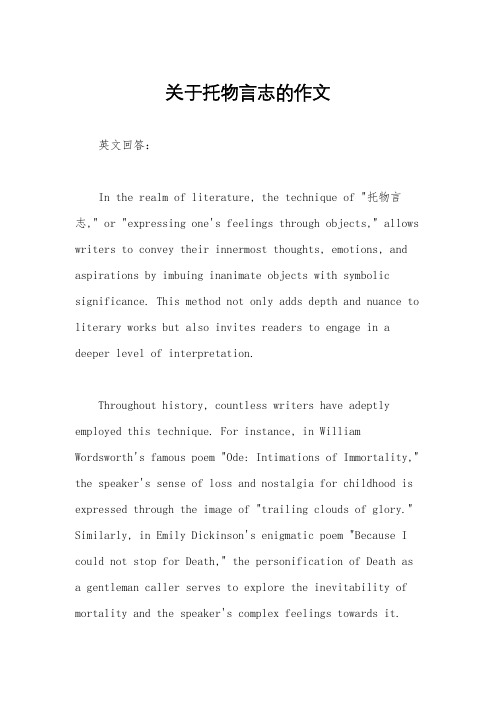
关于托物言志的作文英文回答:In the realm of literature, the technique of "托物言志," or "expressing one's feelings through objects," allows writers to convey their innermost thoughts, emotions, and aspirations by imbuing inanimate objects with symbolic significance. This method not only adds depth and nuance to literary works but also invites readers to engage in a deeper level of interpretation.Throughout history, countless writers have adeptly employed this technique. For instance, in William Wordsworth's famous poem "Ode: Intimations of Immortality," the speaker's sense of loss and nostalgia for childhood is expressed through the image of "trailing clouds of glory." Similarly, in Emily Dickinson's enigmatic poem "Because I could not stop for Death," the personification of Death as a gentleman caller serves to explore the inevitability of mortality and the speaker's complex feelings towards it.In Chinese literature, the concept of 托物言志 has been equally prevalent. The use of objects to convey personal sentiments can be traced back to the classical era, with notable examples found in the works of poets such as Li Bai and Du Fu. For instance, in Li Bai's famous poem "Quiet Night Thoughts," the poet's longing for home is symbolized by the lonely moon reflected in the water, while in Du Fu's "The Thatched Hut," the dilapidated state of the hut mirrors the poet's own hardships and frustrations.Beyond poetry, the technique of 托物言志 has also been effectively utilized in other literary genres, such as prose and drama. In the nov el "Les Misérables" by Victor Hugo, the character of Jean Valjean's redemption is symbolically represented through his encounter with a bishop who offers him compassion and forgiveness. In the play "Death of a Salesman" by Arthur Miller, the protagonist Willy Loman's failure to achieve the American Dream is reflected in his obsession with the "jungle" that symbolizes the harsh realities of business.In conclusion, the technique of 托物言志, or expressing one's feelings through objects, is a powerful tool that enables writers to convey complex emotions and themes in a subtle and evocative manner. By imbuing inanimate objects with symbolic significance, writers can invite readers to engage in a deeper level of interpretation and connect with the universal human experiences that lie beneath the surface of words.中文回答:托物言志,通过对象表达心声。
最新7月全国自考英美文学选读试题及答案解析
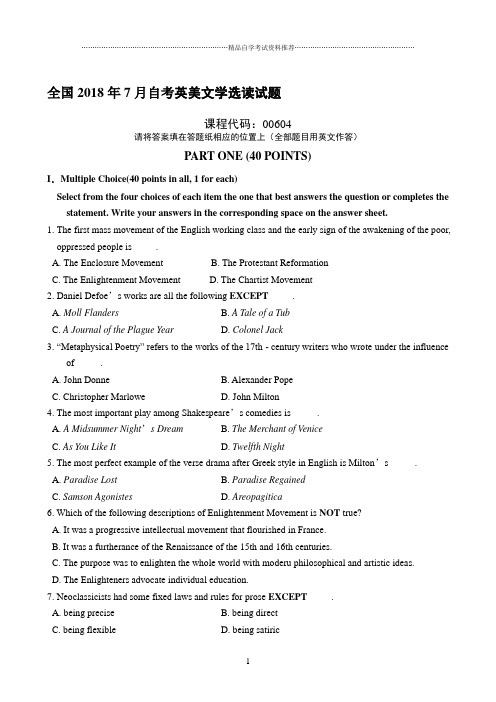
全国2018年7月自考英美文学选读试题课程代码:00604请将答案填在答题纸相应的位置上(全部题目用英文作答)PART ONE (40 POINTS)I.Multiple Choice(40 points in all, 1 for each)Select from the four choices of each item the one that best answers the question or completes the statement. Write your answers in the corresponding space on the answer sheet.1. The first mass movement of the English working class and the early sign of the awakening of the poor, oppressed people is_____.A. The Enclosure MovementB. The Protestant ReformationC. The Enlightenment MovementD. The Chartist Movement2. Daniel Defoe’s works are all the following EXCEPT_____.A. Moll FlandersB. A Tale of a TubC. A Journal of the Plague YearD. Colonel Jack3. “Metaphysical Poetry” refers to the works of the 17th - century writers who wrote under the influenceof _____.A. John DonneB. Alexander PopeC. Christopher MarloweD. John Milton4. The most important play among Shakespeare’s comedies is _____.A. A Midsummer Night’s DreamB. The Merchant of VeniceC. As You Like ItD. Twelfth Night5. The most perfect example of the verse drama after Greek style in English is Milton’s _____.A. Paradise LostB. Paradise RegainedC. Samson AgonistesD. Areopagitica6. Which of the following descriptions of Enlightenment Movement is NOT true?A. It was a progressive intellectual movement that flourished in France.B. It was a furtherance of the Renaissance of the 15th and 16th centuries.C. The purpose was to enlighten the whole world with moderu philosophical and artistic ideas.D. The Enlighteners advocate individual education.7. Neoclassicists had some fixed laws and rules for prose EXCEPT_____.A. being preciseB. being directC. being flexibleD. being satiric8. A good style of prose“proper works in proper places”was defined by_____.A. John MiltonB. Henry FieldingC. Jonathan SwiftD.T.S. Eliot9. The major theme of Jane Austen’s novels is_____.A. love and moneyB. money and social statusC. social status and marriageD. love and marriage10. Wordsworth’s_____ is perhaps the most anthologized poem in English literature.A. “To a Skylark”B. “I Wondered Lonely as a Cloud”C. “An Evening Walk”D. “My Heart Leaps Up”11. William Blake’s work ______ marks his entry into maturity.A. Songs of ExperienceB. Marriage of Heaven and HellC. Songs of InnocenceD. The Book of Los12. Best of all the Romantic well- known lyric pieces is Shelley’s_____.A. “The Cloud”B. “To a Skylark”C. “Ode to a Nightingale”D. “Ode to the West Wind”13. In the Victorian Period _____ became the most widely read and the most vital and challenging expression of progressive thought.A. poetryB. novelC. proseD. drama14. In Charles Dickens’early novels, he attacks one or more specific social evils, _____is a good example of describing the dehumanizing workhouse system and the dark, criminal underworld life.A. David CopperfieldB. Oliver TwistC. Great ExpectationsD. Dombey and Son15. Thomas Hardy’s most cheerful and idyllic work is_____.A. The Return of the NativeB. Far from the Maddin CrowdC. Under the Greenwood TreeD. The Woodlanders16. The rise of _____and new science greatly incited modernist writers to make new explorations on human natures and human relationships.A. the existentialistic ideaB. the irrational philosophyC. scientific socialismD. social Darwinism17. In Modern English literature, the literary interest of _____ lay in the tracing of the psychological development of his characters and in his energetic criticism of the dehu-manizing effect of the capitalist industrialization on human nature.A. George Bernard ShawB.T.S. EliotC. Oscar WildeD.D.H. Lawrence18. George Bernard Shaw’s _____ is a better play of the later period, with the author’s almost nihilistic bitterness on the subjects of the cruelty and madness of WWI and the aimlessness and disillusion of the young.A. Too True to Be GoodB. Mrs. Warren’s ProfessionC. Widowers’HousesD. Fanny’s First Play19. Renaissance first started in Italy, with the flowering of the following fields EXCEPT_____.A. architectureB. paintingC. sculptureD. literature20. English Romanticism,as a historical phase of literature,is generally said to have begun with the publication of Wordsworth and Coleridge’s_____.A. Poetical SketchesB. A Defence of PoetryC. Lyrical BalladsD. The Prelude21. Charlotte Bront e ’s work _____ is famous for the depiction of the life of the middle - class working women, particularly governesses.A. Jane EyreB. Wuthering HeightsC. The ProffessorD. Shirley22. The Waste Land by T. S. Eliot is a poem concerned with the _____ breakup of a modern civilization in which human life has lost its meaning, significance and purpose.A. spiritualB. religiousC. politicalD. physical23. Perhaps Emily Dickinson’s greatest interpretation of the moment of _____ is to be found in “I heard a Fly buzz--when I died—”, a poem universally regarded as one of her masterpieces.A. fantasyB. birthC. crisisD. death24. The fiction of the American _____ period ranges from the comic fables of Washing-ton Irving to the social realism of Rebecca Harding Davis.A. RomanticB. RevolutionaryC. ColonialD. Modernistic25. The modern _____ technique was frequently and skillfully exploited by Faulkner to emphasize the reactions and inner musings of the narrator.A. stream - of - consciousnessB. flashbackC. mosaicD. narrative and argumentative26. By means of “_____,”Whitman believed, he has turned the poem into an openfield, an area of vital possibility where the reader can allow his own imagination to play.A. balanced structureB. free verseC. fixed verseD. regular rhythm27. In 1954, _____ was awarded the Nobel Prize for “his powerful style -forming mas tery of the art”of creating modern fiction.A. Ernest HemingwayB. Sherwood AndersonC. Stephen CraneD. Henry James28. The period ranging from 1865 to 1914 has been referred to as the Age of _____ in the literary history of the United States, which is actually a movement or tendency that dominated the spirit of American literature.A. RationalismB. RomanticismC. RealismD. Modernism29. When he was eighty - seven he read his poetry at the inauguration of President John F. Kennedy in 1961. This poet was_____.A. Ezra PoundB. Robert FrostC. E. E. CummingsD. Wallace Stevens30. The renowned American critic H. L. Mencken regarded _____ as “the true father of our national literature.”A. Bret HarteB. Walt WhitmanC. Washington IrvingD. Mark Twain31. We can easily find in Theodore Dreiser’s fiction a world of jungle, where “kill or to be killed”was the law. Dreiser’s _____ found expression in almost every book he wrote.A. naturalismB. romanticismC. cubismD. classicalism32. A preoccupation with the Calvinistic view of _____ and the mystery of evil marked the works of Hawthorne, Melville and a host of lesser writers.A. love and mercyB. bitterness and hatredC. original sinD. eternal life33. “H e possessed none of the usual aids to a writer’ s career: no money, no friend in power, no formal education worthy of mention, no family tradition in letters. ”This is a description most suitable to the American writer_____.A. Henry JamesB. Theodore DreiserC. W.D. Howells D. Nathaniel Hawthorne34. People generally considered _____ to be Henry James’ masterpiece, which incar nates the clash between the Old World and the New in the life journey of an American girl in a European cultural environment.A. The EuropeansB. Daisy MillerC. The Portrait of A LadyD. The Private Life35. The Jazz Age of the 1920s characterized by frivolity and carelessness is brought vividly to life in_______.A. The Great GatsbyB. The Sun Also RisesC. The Grapes of WrathD. Tales of the Jazz Age36. Guided by the principle of adhering to the truthful treatment of life, the American _______ introduced industrial workers and farmers, ambitious businessmen and vagrants, prostitutes and unheroic soldiers as major characters in fiction.A. romanticistsB. modernistsC. psychologistsD. realists37. The American literary spokesman of the Jazz Age is often acclaimed to be_______.A. Henry JamesB. Robert FrostC. William FaulknerD.F. Scott Fitzgerald38. By writing Moby - Dick, _______ reached the most flourishing stage of his literary creativity.A. Herman MelvilleB. Edgar Ellen PoeC. William FaulknerD. Theodore Dreiser39. Faulkner once said that _____ is a story of “lost innocence,”which proves itself to be an intensification of the theme of imprisonment in the past.A. Light in AugustB. The Sound and the Fur yC. Absalom, Absalom!D. The Hamlet40. Hawthorne was not a Puritan himself, but his view of man and human history origina ted, to a great extent, in_______.A. CalvinismB. PuritanismC. RealismD. NaturalismPART TWO (60 POINTS)Ⅱ. Reading Comprehension (16 points in all, 4 for each)Read the quoted parts carefully and answer the questions in English. Write your answers in the corresponding space on the answer sheet.41. Behold her, single in the field,Yon solitary Highland lass!Reaping and singing by herself;Stop here, or gently pass!Alone she cuts and binds the grain,And sings a melancholy strain;O listen! For the Vale profoundIs overflowing with the sound.Questions:A. Identify the poet.B. What’ s the rhyme scheme for the stanza?C. What’s the theme of the poem?42. The following quotation is from Mrs. Warren’s Profession:VIVIE: [ intensely interested by this time] No; but why did you choose that business?Saving money and good management will succeed in any business.MRS. WARREN: Yes, saving money. But where can a woman get the money to save in any other business?Could you save out of four shillings a week and keep yourself dressed as well? Not you. Of course, ifyou’ re a plain woman and cant earn anything more ; or if you have a turn for music, or the stage, ornewspaper - writing ; that’s different...Questions :A. Identify the playwright of the above quotation.B. What business do you think Mrs. Warren is involved in?C. What's the theme of the play?43. My little horse must think it queerTo stop without a farmhouse nearBetween the woods and frozen lakeThe darkest evening of the year.Questions:A. Identify the poet and the title of the poem from which this stanza is taken.B. What figure of speech is used in this stanza?C. Briefly interpret the meaning of this stanza.44. “Where are we going, Dad?”Nick asked.“Over to the Indian camp. There is an Indian lady very sick. ”“Oh,”said Nick.Across the bay they found the other boat beached. Uncle George was smoking a cigar in the dark. The young Indian pulled the boat way up on the beach. Uncle George gave both the Indians cigars.Questions :A. Identify the author and the title of the work from which the passage is taken.B. What does Dad imply when he says “There is an Indian lady very sick”?C. Why is Dad going to the Indian camp?Ⅲ. Questions and Answers (24 points in all, 6 for each)Give a brief answer to each of the following 9uestions in English. Write your answers in the corresponding space on the answer sheet.45. What’ s the literary style of Shelley as a Romantic poet?46. What are the main features of Bernard Shaw’s plays with regard to the theme, charac-terization and plot?47. Henry James’ literary criticism is an indispensable part of his contribution to literature. What’s his outlook inliterary criticiam?48. Local colorism is a unique variation of American literary realism. Who is the most famous local colorist?What are local colorists most concerned?IV. Topic Discussion(20 points in all, 10 for each)Write no less than 150 words on each of the following topics in English in the corresponding space on the answer sheet.49. Define modernism in English literature. Name two major modernistic British writers and list one major workby each.50. Briefly discuss the term “The Lost Generation”and name the leading figures of this literary movement (Giveat least three).。
走向反符号主义:艾米丽 狄金森诗歌《我是无名之辈!你是谁?》的符号式解读
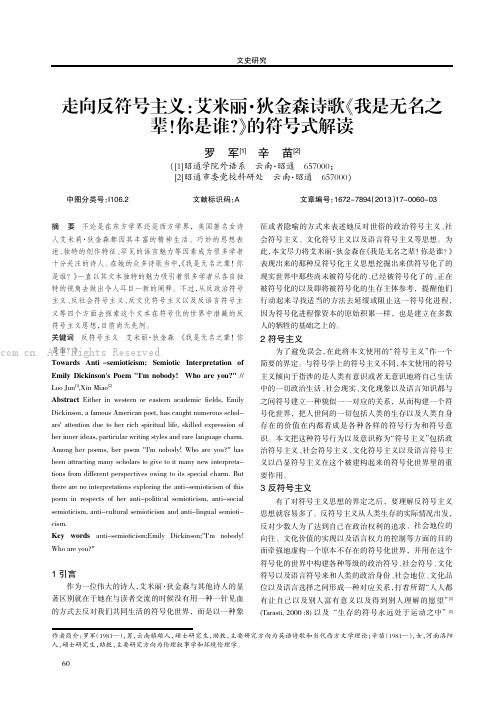
走向反符号主义:艾米丽·狄金森诗歌《我是无名之辈!你是谁?》的符号式解读罗军[1]辛苗[2]([1]昭通学院外语系云南·昭通657000;[2]昭通市委党校科研处云南·昭通657000)中图分类号:I106.2文献标识码:A文章编号:1672-7894(2013)17-0060-03摘要不论是在东方学界还是西方学界,美国著名女诗人艾米莉·狄金森都因其丰富的精神生活、巧妙的思想表述、独特的创作特征、罕见的语言魅力等因素成为很多学者十分关注的诗人。
在她的众多诗歌当中,《我是无名之辈!你是谁?》一直以其文本独特的魅力吸引着很多学者从各自独特的视角去做出令人耳目一新的阐释。
不过,从反政治符号主义、反社会符号主义、反文化符号主义以及反语言符号主义等四个方面去探索这个文本在符号化的世界中潜藏的反符号主义思想,目前尚无先例。
关键词反符号主义艾米丽·狄金森《我是无名之辈!你是谁?》Towards Anti-semioticism:Semiotic Interpretation of Emily Dickinson's Poem"I'm nobody!Who are you?"// Luo Jun[1],Xin Miao[2]Abstract Either in western or eastern academic fields,Emily Dickinson,a famous American poet,has caught numerous schol-ars'attention due to her rich spiritual life,skilled expression of her inner ideas,particular writing styles and rare language charm. Among her poems,her poem"I'm nobody!Who are you?"has been attracting many scholars to give to it many new interpreta-tions from different perspectives owing to its special charm.But there are no interpretations exploring the anti-semioticism of this poem in respects of her anti-political semioticism,anti-social semioticism,anti-cultural semioticism and anti-lingual semioti-cism.Key words anti-semioticism;Emily Dickinson;"I'm nobody! Who are you?"1引言作为一位伟大的诗人,艾米丽·狄金森与其他诗人的显著区别就在于她在与读者交流的时候没有用一种一针见血的方式去反对我们共同生活的符号化世界,而是以一种象征或者隐喻的方式来表述她反对世俗的政治符号主义、社会符号主义、文化符号主义以及语言符号主义等思想。
Emily Dickinson-abstract
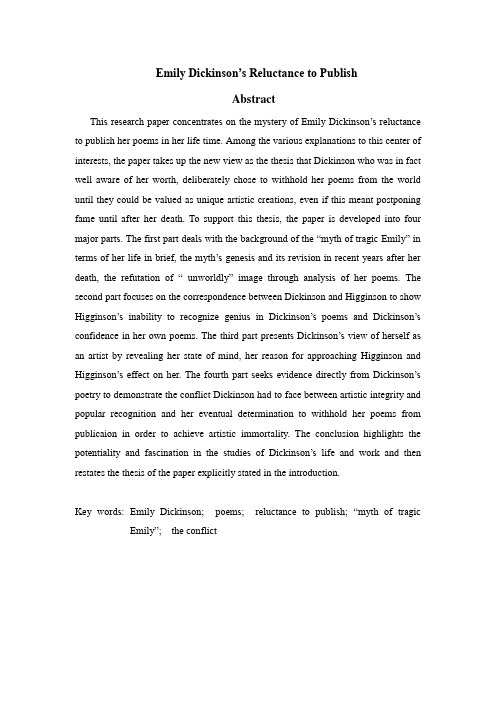
Emily Dickinson’s Reluctance to PublishAbstractThis research paper concentrates on the mystery of Emily Dickinson’s reluctance to publish her poems in her life time. Among the various explanations to this center of interests, the paper takes up the new view as the thesis that Dickinson who was in fact well aware of her worth, deliberately chose to withhold her poems from the world until they could be valued as unique artistic creations, even if this meant postponing fame until after her death. To support this thesis, the paper is developed into four major parts. The first part deals with the background of the “myth of tragic Emily” in terms of her life in brief, the myth’s genesis and its revision in recent years after her death, the refutation of “ unworldly” image through analysis of her poems. The second part focuses on the correspondence between Dickinson and Higginson to show Higginson’s inability to recognize genius in Dickinson’s poems and Dickinson’s confidence in her own poems. The third part pres ents Dickinson’s view of herself as an artist by revealing her state of mind, her reason for approaching Higginson and Higginson’s effect on her. The fourth part seeks evidence directly from Dickinson’s poetry to demonstrate the conflict Dickinson had to face between artistic integrity and popular recognition and her eventual determination to withhold her poems from publicaion in order to achieve artistic immortality. The conclusion highlights the potentiality and fascination in the studies of Dickinson’s l ife and work and then restates the thesis of the paper explicitly stated in the introduction.Key words: Emily Dickinson; poems; reluctance to publish; “myth of tragic Emily”; the conflict。
Emily-Dickinson-迪金森作家及作品介绍_OK
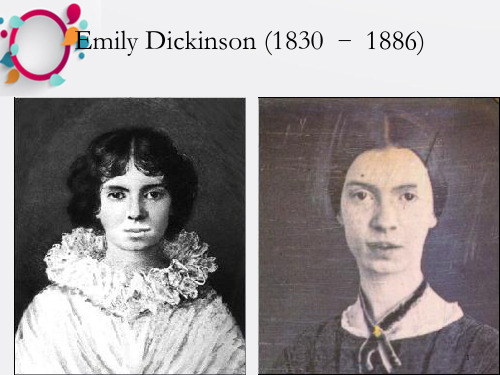
continuous fragmented "letter to the world," a way to bridge her private
wor2l0d21/w7/i2t2h the public.
17
moment of death
2021/7/22
18
“I heard a Fly buzz – when I died –” 我死的时候—听见一只苍蝇嗡嗡地响
2021/7/22
8
The themes in Dickinson’s poems
3.Love
Love is another subject Dickinson dwelt on. One group of her love poems treats the suffering and frustration love can cause. These poems are clearly the reflection of her own unhappy experience, closely related to her deepest and most private feelings.
2021/7/22
13
Dickinson’s artistic characteristics
4) The form of her poetry is familiar, communal (公共的), and sometimes, irregular.
5) short; a singly image or symbol ; one subject matter. 6) personal and meditative. 7) She often used persona and personification
爱情·死亡·永恒——艾米莉·狄金森诗歌解读
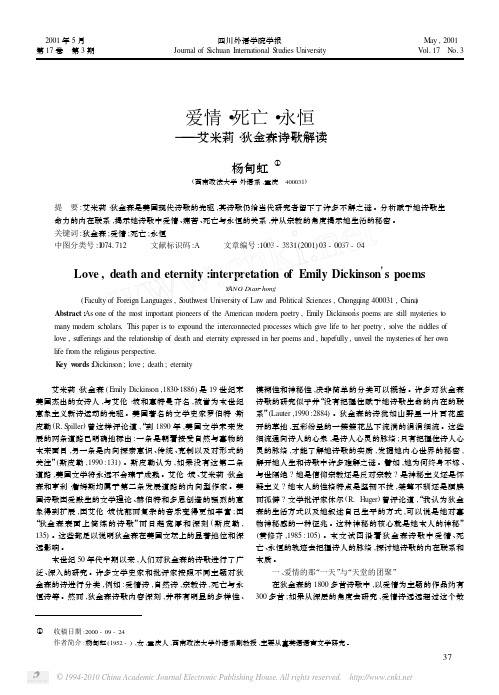
2001年5月第17卷 第3期四川外语学院学报Journal of S ichuan International S tudies UniversityMay,2001V ol.17 N o.3爱情・死亡・永恒———艾米莉・狄金森诗歌解读杨甸虹①(西南政法大学外语系,重庆 400031)提 要:艾米莉・狄金森是美国现代诗歌的先驱,其诗歌仍给当代研究者留下了许多不解之谜。
分析赋予她诗歌生命力的内在联系,揭示她诗歌中爱情、痛苦、死亡与永恒的关系,并从宗教的角度揭示她生活的秘密。
关键词:狄金森;爱情;死亡;永恒中图分类号:I0741712 文献标识码:A 文章编号:1003-3831(2001)03-0037-04Love,death and eternity:interpretation of Emily Dickinsonπs poemsY ANG Dian2hong(Faculty of F oreign Languages,S outhwest University of Law and P olitical Sciences,Chongqing400031,China) Abstract:As one of the m ost important pioneers of the American m odern poetry,Emily Dickins onπs poems are still mysteries to many m odern scholars1This paper is to expound the interconnected processes which give life to her poetry,s olve the riddles of love,su fferings and the relationship of death and eternity expressed in her poems and,hopefully,unveil the mysteries of her own life from the religious perspective1K ey w ords:Dickins on;love;death;eternity 艾米莉・狄金森(Emily Dickins on,183021886)是19世纪末美国杰出的女诗人,与艾伦・坡和惠特曼齐名,被誉为本世纪意象主义新诗运动的先驱。
emilydickinson的诗

emilydickinson的诗Emily Dickinson's Poetry: A Glance into Her SoulEmily Dickinson is one of America's greatest poets, yet during her lifetime, only a few of her works were published. Dickinson's poems are known for her unique style and their exploration of themes such as death, immortality, spirituality, and nature. Her poems are characterized by their distinct form and syntactical complexity, often using dashes and unconventional capitalization to create a sense of breathlessness and urgency.One of her most famous poems, "Because I could not stop for Death", explores the theme of mortality. In the poem, Dickinson personifies death as a gentleman caller who takes her on a carriage ride through various stages of life, until they finally arrive at her final resting place. This poem showcases Dickinson's fascination with death – a recurring motif in her poetry.Another one of Dickinson's well-known poems is "Hope is the thing with feathers". This poem metaphorically compares hope to a bird that resides in the human soul, constantly singing and giving us strength. Dickinson's use of metaphor and imagery in this poem is a testament to her skill as a poet.Dickinson's poetry was heavily influenced by her personal experiences and beliefs. She was a deeply religious person who often questioned the nature of God and the afterlife. Her poetry frequently reflects her doubts and existential questions, as in the poem "I felt a funeral in my brain", where she describes the feeling of being overwhelmed by grief and the fear of notknowing what comes after death.One of the things that sets Dickinson's poetry apart is her use of slant rhyme and unconventional syntax. Her poems often follow a strict meter but are constructed in a way that defies the reader's expectations. This technique, along with her frequent use of dashes and capitalization, gives her work a unique musical quality.Dickinson's work has been the subject of much analysis and interpretation over the years. Her poetry has been read as an exploration of the human psyche, a critique of societal norms, and a commentary on the nature of reality. However, despite the countless interpretations and analyses, Dickinson's poetry remains as enigmatic and mysterious as she was in life.In conclusion, Emily Dickinson's poetry is a testament to her skill as a poet and her complicated inner world. Her unique style and exploration of themes such as death and religion make her a significant figure in American poetry. Dickinson's work continues to fascinate and inspire readers even today, over a century after her death.。
Emily Elizabeth Dickinson

Emily Elizabeth Dickinson (December 10, 1830 –May 15, 1886) Born in Amherst, Massachusetts, to a successful family with strong community ties, she lived a mostly introverted and reclusive life. The Dickinson family was prominent in Amherst. In fact, Emily's grandfather, Samuel Fowler Dickinson, was one of the founders of Amherst College, and her father served as lawyer and treasurer for the institution. Emily's father also served in powerful positions on the General Court of Massachusetts, the Massachusetts State Senate, and the United States House of Representatives. Thought of as an eccentric by the locals, she became known for her penchant for white clothing and her reluctance to greet guests or, later in life, even leave her room. Most of her friendships were therefore carried out by correspondence. Although most of her acquaintances were probably aware of Dickinson's writing, it was not until after her death in 1886 that her younger sister discovered the collections of writing.Dickinson's poems are unique for the era in which she wrote; they contain short lines, typically lack titles, and often use slant rhyme (an inexact rhyme where the final consonant sounds are the same but the vowel sounds are different. “And by his smile, I knew that sullen hall, /By his dead smile I knew we stood in Hell”.), bald images as well as unconventional capitalization and punctuation. Many of her poems deal with themes of death and immortality, two recurring topics in letters to her friends.Death: Dickinson was troubled from a young age by the "deepening menace" of death, especially the deaths of those who were close to her. When Sophia Holland, her second cousin and a close friend, grew ill from typhus (斑疹伤寒)and died in April, 1844, Emily was traumatized. When she was eighteen, Dickinson's family befriended a young attorney by the name of Benjamin Franklin Newton. According to a letter written by Dickinson after Newton's death, he had been "with my Father two years, before going to Worcester – in pursuing his studies, and was much in our family." Although their relationship was probably not romantic, Newton was a formative influence and would become the second in a series of older men (after Humphrey) that Dickinson referred to, variously, as her tutor, preceptor or master. Newton likely introduced her to the writings of William Wordsworth, and Ralph Waldo Emerson's first book of collected poems. She wrote later that he, "whose name my Father's Law Student taught me, has touched the secret Spring". Newton held her in high regard, believing in and recognizing her as a poet. When he was dying of tuberculosis, he wrote to her, saying that he would like to live until she achieved the greatness he foresaw Biographers believe that Dickinson's statement of 1862—"When a little Girl, I had a friend, who taught me Immortality –but venturing too near, himself –he never returned"—refers to Newton.The Amherst Academy principal, Leonard Humphrey, died suddenly of "brain congestion" at age 25. Two years after his death, she revealed to her friend Abiah Root the extent of her depression: "...some of my friends are gone, and some of my friends are sleeping – sleeping the churchyard sleep – the hour of evening is sad – it was once my study hour – my master has gone to rest, and the open leaf of the book, and the scholar at school alone, make the tears come, and I cannot brush them away; I would not if I could, for they are the only tribute I can pay the departed Humphrey".Love:Until 1855, Dickinson had not strayed far from Amherst. That spring, accompanied by her mother and sister, she took one of her longest and farthest trips away from home. InPhiladelphia, she met Charles Wadsworth,a famous minister of the Arch Street Presbyterian Church, with whom she forged a strong friendship which lasted until his death in 1882. Despite only seeing him twice after 1855,she variously referred to him as "my Philadelphia", "my Clergyman", "my dearest earthly friend" and "my Shepherd from 'Little Girl'hood". Charles Wadsworth is often mentioned as the love of Emily Dickinson’s life. He was 41 years old, married and had a family. There are drafts of three letters to him, which followed his visit to her in 1960, and the words afterwards have been considered ―love poems.‖ When she learned of his impending move to San Francisco, she wrote: ―I had a terror since September, I could tell to none….‖The soul selects her own societyThe soul selects her own society, 靈魂選擇她自己的伴侶Then shuts the door; 接著把門緊閉On her divine majority 在她那神聖的決擇Obtrude no more. 再毋容打擾Unmoved, she notes the chariot’s pausing 此志不移,即使她注意到香車恭迎At her low gate; 在她蓬門前Unmoved, an emperor is kneeling 此志不移,即使一位皇帝皇親跪Upon her mat. 於她門墊上I ’ve known her from an ample nation 我知道她從一個花花世界Choose one; 擇一Then close the valves of her attention 然後關閉心扉再不動容Like stone. 如石。
Emily Dicksion
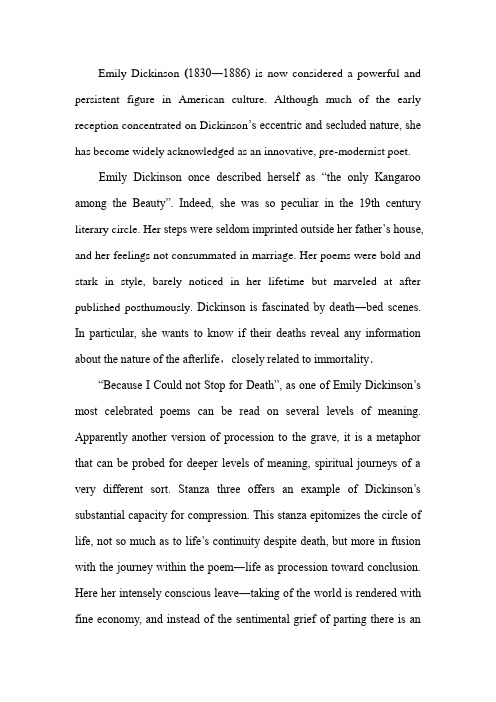
Emily Dickinson(1830―1886)is now considered a powerful and persistent figure in American culture. Although much of the early reception concentrated on Dickinson’s eccentric and secluded nature, she has become widely acknowledged as an innovative, pre-modernist poet.Emily Dickinson once described herself as “the only Kangaroo among the Beauty”. Indeed, she was so peculiar in the 19th century literary circle. Her steps were seldom imprinted outside her father’s house, and her feelings not consummated in marriage. Her poems were bold and stark in style, barely noticed in her lifetime but marveled at after published posthumously. Dickinson is fascinated by death―bed scenes. In particular, she wants to know if their deaths reveal any information about the nature of the afterlife,closely related to immortality.“Because I Could not Stop for Death”, as one of Emily Dickinson’s most celebrated poems can be read on several levels of meaning. Apparently another version of procession to the grave, it is a metaphor that can be probed for deeper levels of meaning, spiritual journeys of a very different sort. Stanza three offers an example of Dickinson’s substantial capacity for compression. This stanza epitomizes the circle of life, not so much as to life’s continuity despite death, but more in fusion with the journey within the poem―life as procession toward conclusion. Here her intensely conscious leave―taking of the worl d is rendered with fine economy, and instead of the sentimental grief of parting there is anobjectively presented scene. The seemingly disparate parts of this are fused into a vivid re-enactment of the mortal experience. It includes the three stages of youth, maturity, and age, the cycle of day from morning to evening, and even a suggestion of seasonal progression from the years upspring through ripening to decline. The labor and leisure of life are made concrete in the joyous activity of children contrasted with the passivity of nature and again, by the optical illusion of the sun’s setting, in the image of motion that has come to rest. Also the whole range of the earthly life is symbolized, first human nature, then animate, and finally inanimate nature. B ut, absorbed “in the Ring” of childhood’s games, the players at life do not even stop to look up at the passing carriage of death. Time is on the move even for them, though its pace seems slow.And the indifference of nature is given a kind of cold vitality by transferring the stare in the dead traveler’s eyes to the “Gazing Grain”. This simple maneuver in grammar creates a paradox, giving the fixity of death to the living corn while the couple itself passes by on its journey to immortality. Then with th e western sun, traditional symbol of the soul’s passing comes the obliterating darkness of eternity. Finally, the sequence follows the natural route of a funeral train, past the schoolhouse in the village, then the outlying fields, and on to the remote burying ground.The only pressing technical objection to this poem is the remark that “Immortality” in the first stanza is a meretricious and unnecessarypersonification. But the common sense of the situation demands that Immortality ought to be the destination of the coach and not one of the passengers. The personification of death, however, is unassailable. In the literal meaning of the poem, he is apparently a successful citizen who is amorous but genteel intentions. He is also God.Emily Dickinson envisions Death as a person she knew and trusted. His graciousness is a mark of special politeness in taking time to stop for her at that point and on that day in her life when she was so busy she could not be possible to have time to stop for him. They drove in a leisurely manner and she feels completely at ease.Because I Could not stop for Death―He kindly stopped for me―The Carriage held but just Ourselves―And Immortality.We slowly drove―He knew no hasteAnd I had put awayMy Labor and my leisure too,For His Civility―We passed the school, where Children stroveAt Recess―in the Ring―We passed the Fields of Gazing Grain―We passed the Setting Sun―Or rather―He passed us―The Dews drew quivering and chill―For only Gossamer, my Gown―My Tippet―only Tulle―We paused before a House that seemed A swelling of Ground―The Roof was scarcely visible―The Cornice―in the Ground―Since then―it’s Centuries―and yet Feels shorter than the DayI first surmised the Horse’s Heads Were toward Eternity―。
美国文学题型
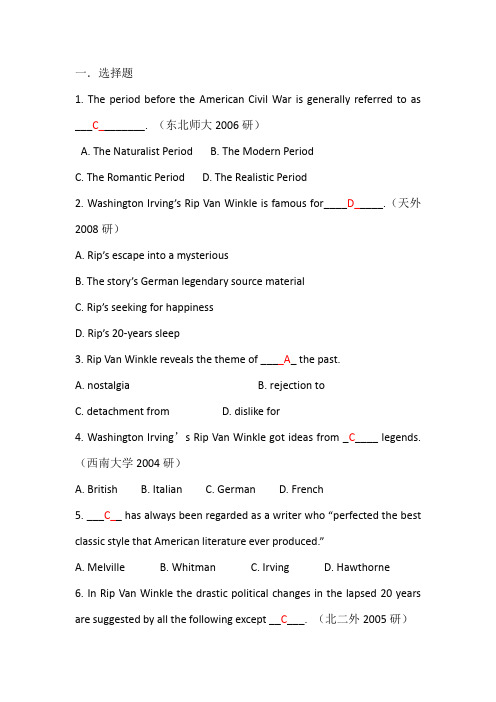
一.选择题1. The period before the American Civil War is generally referred to as ___C________. (东北师大2006研)A. The Naturalist PeriodB. The Modern PeriodC. The Romantic PeriodD. The Realistic Period2. Washington Irving’s Rip Van Winkle is famous for____D_____.(天外2008研)A. Rip’s escape into a mysteriousB. The story’s German legendary source materialC. Rip’s seeking for happinessD. Rip’s 20-years sleep3. Rip Van Winkle reveals the theme of ____A_ the past.A. nostalgiaB. rejection toC. detachment fromD. dislike for4. Washington Irving’s Rip Van Winkle got ideas from _C____ legends. (西南大学2004研)A. BritishB. ItalianC. GermanD. French5. ___C__ has always been regarded as a writer who “perfected the best classic style that American literature ever produced.”A. MelvilleB. WhitmanC. IrvingD. Hawthorne6. In Rip Van Winkle the drastic political changes in the lapsed 20 years are suggested by all the following except __C___. (北二外2005研)A. the flag of the USB. the portrait of George WashingtonC. the graves of the dead Union soldiersD. the mention of election and Congress7.Which of the following statement is not true about Washington Irving?(中南2006研)CA. Washington Irving is regarded as Father of the American short stories.B. Irving’s relationship with the Old World in terms of his literary imagination can hardly be ignored considering his success both abroad and at home.C. Irving’s taste was essentially progressive or radical.D. Washington Irving has always been regarded as a writer who "perfected the best classic style that American literature ever produced."8.Henry David Thoreau’s work, ____A____, has always been regarded asa masterpiece of the New England Transcendental Movement.A. WaldenB. The PioneersC. NatureD. "Song of Myself"9."There is evil in every human heart, which may remain latent, perhaps, through the whole life; but circumstances may rouse it to activity", which author of the following authors does the mention belong to__C______.A. Washington IrvingB. Ralph Waldo EmersonC. Nathaniel HawthorneD. Walt Whitman10.In Hawthorne’s novels and short stories, intellectuals usually appear as ____B____.A. saviorsB. villainsC. commentatorsD. observers11."Nothing is at last sacred but the integrity of your own mind" is a famous quote from__D____’s writings.A. Walt WhitmanB. Henry David ThoreauC. Herman MelvilleD. Ralph Waldo Emerson12.The Publication of _A_____established Emerson as the most eloquent spokesman of New England Transcendentalism.A. NatureB. Self-RelianceC. The American ScholarD. The Over-Soul13.The phrase "a transparent eye-ball’ compares philosophical mentation of Emerson’s. It appears in____B_____.A. The American ScholarB. NatureC. The over SoulD. Essays: Second Series14.In 1837, Ralph Waldo Emerson made a speech entitled __C_____at Harvard, which was hailed by Oliver Wendell Holmeasas :Our Intellectual Declaration of Independence".A. "Self-Reliance"B. "Divinity School Address"C. "The American Scholar"D. "Nature"15.The Transcendentalists believe that, first, nature is ennobling, and second, the individual is__C__, therefore, self-reliant.A. insignificantB. vicious by natureC. divineD. forward-looking16.In the following works, which sign the beginning of the Americanliterature? AA. The Sketch BookB. Leaves of GrassC. Leather Stocking TalesD. Adventures of Huckleberry Finn17. ____C_ is the first American to achieve an international literary reputation in the American literary history.A. CooperB. WhitmanC. IrvingD. Hawthorne.18.__A___ is the author of the work The Legend of Sleepy Hollow.A. Washington IrvingB. James JoyceC. Walt WhitmanD. William Butler Yeats19.Washington Irving’s Rip Van Winkle is famous for_______D__.A. Rip’s escape into a mysteriousB. The story’s German legendary source materialC. Rip’s seeking for happinessD. Rip’s 20-years sleep20.Rip Van Winkle reveals the theme of ___A__ the past.A. nostalgiaB. rejection toC. detachment fromD. dislike for21.Washington Irving’s Rip Van Winkle got ideas from __C___ legends.A. BritishB. ItalianC. GermanD. French22.__C___ has always been regarded as a writer who "perfected the best classic style that American literature ever produced."A. MelvilleB. WhitmanC. IrvingD. Hawthorne23.In Rip Van Winkle the drastic political changes in the lapsed 20 years are suggested by all the following except __C___.A. the flag of the USB. the portrait of George WashingtonC. the graves of the dead Union soldiersD. the mention of election and Congress24.In his_Autobiography____, Benjamin Franklin creates the image of a boy’s rise from ___poors___to riches and demonstrates his belief that the new world of America was a land of opportunities which might be met through hard work and wise management.(天津外国语2008)25.The first symbol of self-made American man is ___D__.A. George WashingtonB. Washington IrvingC. Thomas JeffersonD. Benjamin Franklin26. Thomas Paine’s Commen Sense____ states that “Government, even in its best state, is but a necessary evil; in his worst state an intolerable one”.27.It is a critical commonplace now that American literature is based on a myth, that is _C___.A. the ancient Greek myth of ZeusB. the British myth of the Saint GrailC. the Biblical myth of the Garden of EdenD. the Legend of the Sleepy Hollow28.The first permanent English settlement in North America was established at __A_.A. JamestownB. New YorkC. BostonD. Concord29.What is the analogy that Emily Dickinson uses in the her poem “Because I could stop for Death” ?AA. Horse and carriageB. Stage and performanceC. Cloud and shadeD. Ship and harbor30.In “I heard a Fly buzz ---when I died” and “Because I could not stop for Death,” Emily Dickinson’s attitude toward death is that of _C___.A. eager embraceB. helpless anxietyC. peaceful acceptanceD. terrified despair31.Perhaps Emily Dickinson’s greatest interpretation of the moment of _D____ is to be found in “I heard a Fly buzz--when I died—”, a poem universally regarded as one of her masterpieces.A. fantasyB. birthC. crisisD. death32.Altogether, Emily Dickinson wrote 1775 poems, of which only ___C___ had appeared during her lifetime.A.three B.five C.seven D.nine33.Which of the following statements is NOT true of Emily Dickinson and her poetry? BA.She remained unmarried all her lifeB.She wrote, 1,775 poems, and most of them were published duringher life time.C.Her poems have no titles, hence are always quoted by their first lines.D.Her limited private world has never confined the limitless power of her creativity and imagination.34.In general, the American woman poet __B___ wanted to live simply as a complete independent being,and so she did,as a spinster.A. Anne BretB. Emily DickinsonC. Anna DickinsonD. Emily Shaw35.Though Walt Whitman and Emily Dickinson were romantic poets in theme and technique, they differ from each other in a variety of ways. For one thing, whereas Whitman likes to keep his eye on human society at large, Dickinson often addresses such issues as( D ), immortality, religion, love and nature.A. progressB. freedomC. beautyD. death36.Emily Dickinson wrote many short poems on various aspects of life. Which of the following is not a usual subject of her poetic expression? DA. Religion.B. Life and death.C. Love and marriage.D. War and peace.37.Most of Emily Dickinson’s poems were published __D__.A. When she was young.B. After her failed love affairC. In her old age.D. After her death.二.作家作品1. William Cullen Bryant :To a Waterfowl《致水鸟》Thanatopsis 《死亡随想》The Yellow Violet 《黄色堇香花》2.Walt Whitman:Leaves of Grass (9 editions):①Song of Myself②There Was a Child Went Forth(有一个孩子在成长)③Democratic Vistas (民主远景)the title : It is significant that Whitman entitled his book Leaves of Grass . He said that where there is earth, where there is water, there is grass. Grass, the most common thing with the greatest vitality, is an image of the poet himself, a symbol of the then rising American nation and an embodiment of his ideals about democracy and freedom.3.Philip Freneau's:The Wild Honey Suckle (1786)The Indian Burying Ground(1788)4.Herman Melville:①Moby-Dick (a white whale): His best work and masterpiece; the first American prose epic.(散文体史诗)②Typee «泰皮» ③Mardi «玛地»④Pierre «皮埃尔»⑤Billy Budd 《比利•巴德》5.Henry Wadsworth Longfellow:①Voices of the Night 《夜吟》:A Psalm of Life 《人生礼赞》②Evangeline 《伊凡吉林》③The Song of Hiawatha 《海华沙之歌》④Ballads and Other Poems 《歌谣及其他》6.Nathaniel Hawthorne :Young Goodman Brown 《小伙子布朗》The Scarlet Letter The House of the Seven Gables 《七个尖角阁的房子》7.Henry David Thoreau:Walden:Where I Lived, and What I Lived for.8.Ralph Waldo Emerson:Nature The American Scholar 论美国学者Self-Reliance 论自立The Over-Soul 论超灵9.Edgar Allan Poe:The Raven, Annabel Lee, To Helen10.James Fenimore Cooper:①The Spy (1821)《间谍》②The Pilot (1824) 《舵手》③Leatherstocking Tales《皮袜子故事集》:The Pioneers (1823), 《拓荒者》The Last of the Mohicans (1826), 《最后的莫西干人》The Prairie (1827), 《大草原》The Pathfinder (1840), 《探路人》The Deerslayer (1841). 《杀鹿者》11.Washington Irving: The Sketch Book《见闻札记》:(1)Rip Van Winkle 《瑞普凡温克尔》(2)The Legend of Sleepy Hollow 《睡谷传奇》12.Thomas Jefferson :the Declaration of Independence (1776)Note on the State of Virginia《弗吉尼亚笔记》13.Thomas Paine:Common Sense《常识》The American Crisis 《危机》14.Bartram:Travels《旅行散记》.15.Benjamin Franklin:Poor Richard’s Almanack 穷理查德年鉴The Way to Wealth 致富之路The Autobiography 自传16.John Smith:A True Relation of Virginia 《关于弗吉尼亚的真实叙述》A Description of New England 《新英格兰叙事》17.John Winthrop:The History of New England《新英格兰史》A Model of Christian Charity 《基督教之爱》18.William Bradford:the History of Plymouth Plantation (annals)19.Anne Bradstreet:the Tenth Muse Lately Sprung up in America.To My Dear and Loving Husband20.Edward Taylor:Upon a Spider Catching a Fly The Ebb and Flow Upon Wedlock and Death of Children God’s Determination Preparatory Meditations21.Emily Dickinson: Over the fence Because I could not stop for Death 因为我不能停下来等候死神I heard a Fly buzz–when I died 我死的时候—听见一只苍蝇嗡嗡地响三.名词解释1.“Gilded Age”镀金时代:an age of extremes of decline and progress,of poverty and dazzling wealth, of gloom and buoyant (持续上涨的)hope.2.Realism:Realism originated in France. A literary doctrine that called for “reality and truth” in the depiction of ordinary life. American Realism came in the latter half of the nineteenth century as a reaction against Romanticism. It stresses t ruthful treatment of material. It focuses on commonness of the lives of the common people, and emphasizes objectivity and offers an objective rather than an idealistic view of human nature and human experience.3.free verse:A kind of poetry that lacks regular meters or patterns. Free verse is the rhymed or unrhymed poetry free from conventional rules of meter.4.predestination:God decided everything before things occurred.5. original sin/total depravity(堕落) : Human beings were born to be evil , and this original sin can be passed down from generation to generation;6.limited atonement: only the “elect” can be saved.7.Half rhyme: Face and Greece are similar only in that they have one syllable and the same ending–"ce." The vowels "a" and "ee" do not rhyme. Thus, face and Greece make up what is called half rhyme, also known as near rhyme, oblique rhyme, and slant rhyme.8.Romanticism: appeared in England in the 18th century. A modern term applied to the profound shift in Western attitudes to art and human creativity in the first half of the 19th c. Reaction against the prevailing neoclassical spirit and rationalism (reason) during the Age of Reason.9.American Puritanism: Puritanism is the practices and beliefs of Puritans. The American puritans, like their English brothers, are idealists. They accept the doctrine and practice of predestination, original sin and total depravity, and limited atonement through a special infusion of grace from God.10.Transcendentalism: That philosophical movement is called the Transcendentalism(超验主义) which helped American literature branch off European culture and heralded the real beginning of American literature which is later called as: American Renaissance.II. Read the quoted part and answer the questions:1. "Time grew worse and worse with Rip Van Winkle as years of matrimony rolled on: a tart temper mellows with age, and a sharp tongue is the only edge tool that grows keener by constant use. For a long while he used to perpetual club of the sages, philosophers, and other idle personages of the village.Questions:1) Please identify the author and the title of the work.2) What’s the meaning of this passage?参考答案:1) This is an excerpt from "Rip Van Winkle" by Washington Irving. (P408)2) With his wife’s dominance at home, the situation became harder and harder for Rip Van Winkle. His wife’s temper became worse and she scolded him for more often. He had to stay in the club with idle people. (P407)附:Question: Please describe the changes Rip Van Winkle experienced. Answer: 1) Rip Van Winkle was the hero in Irving’s works. He was a good-natured man, a henpecked (惧内的,妻管严的) husband.2) Because his wife’s shrewish (泼妇一样的) treatment, Rip had to escape from his home to the little inn in the village. When it failed to give him some restful air, he had to go hunting in the high mountain, where Rip met a stranger, and the man asked Rip to carry keg for him. Then Rip reached the place in the valley, where many strangers were playing nine-pins. Later Rip got drunk after drinking the liquor, which made him sleep for 20 years.3) Rip woke up as an old man, entering the village learned that his wife had died, he got the freedom of his own,; and the American had been dependent from the control of Britain, he had changed from a subject of the King (George III) into a citizen of the independent new U.S.....2. " I celebrated myself, and sing myself,And what I assume you shall assume,For every atom belonging to me as good belongs to you"Questions:1) Please identify the author and the title of the poem that had used when published. 2) What is the theme of this poem?参考答案:1) In the 1856, the title was "Poem of Walt Whitman, an American", then it became "Walt Whitman" in 1860, until 1881, it finally became "Song of Myself". The author is Walt Whitman. (P456--457)2) In this poem Whitman sets forth two principle beliefs:A. The theory of universality (普遍性), which is illustrated by lengthy catalogues of people and things;B. The belief in the singularity (个别性) and equality(平等性) of all beings in value. (P457)3. "Standing on the bare ground, ----my head bathed by the blithe air, and uplifted into infinite space, -----all mean egotism vanishes. I become a transparent eye-ball. I am nothing. I see all."Questions:1) Please identify the author and the title of the work.2) Please briefly interpret this passage.3). What rhetorical device of "transparent eye-ball".4) Emerson said he want to become a transparent eye-ball, what king idea did he want to express?参考答案:1) This selection is from "Nature" by Emerson. (P427)2) In the essay Emerson clearly expresses the main principles of his Transcendentalist pursuit and his love for nature. Emerson develops his concept of "Over-Soul" Or "Universal Mind". Last but not the leas, it affirms the divinity of the human beings. (P423)3) It used the device of metaphor. (P423) 4) He wanted to tell us: Nature can purify (净化) our quality and let us get comfort. (P243)III. Questions and answers:1. The Romantic Period was called "The American Renaissance". Discuss the background of the Romantic Period, and compare it with the Romanticism of Britain.Answer:1) The two Romanticism both stress the imaginative and emotional qualities of literature;2) They all pay attention to psychic states of the characters and exalt the individual and common man;3) American Romanticism revealed unique characteristics: (difference)<1> American authors describe their native land,, especially the spirit of the pioneering into the west, the desire for an escape from society anda return to nature;<2> American writers use local dialect in language;<3> Puritanism has great influence over American Romantics;<4> Calvinism of original sin is obvious in their works;<5> Transcendentalism is very important theory in American Romanticism;<6> The important setting in American Romanticism are: ①the early puritan settlement; ②the confrontation with the Indians; ③the frontiersmen’s life; ④the wild west; ⑤imagination. (P399—402)2. Analyze the themes and characteristic of Hawthorne.Answer:Hawthorne was a man with inquiring imagination, meditative mind and dark vision to life.His themes in writing are:1) Man was born with evil and sin, one source of them is over-reaching intellect, whose image was always villain; (Chllingworth e.g.)2) Hawthorne was influenced greatly by Puritanism, while he criticized it bitterly;3) He believed Calvinistic ideas, thinking man was depraved and corrupted; they should obey God for saving the spirits;4) He concerned the moral life of man and human history;5) He was keen on the description of man’s development of psychology. (P432—433)3. Explain the theory of Transcendentalism, then list its important author and works.Answer:Transcendentalism is a very important theory in American Romanticism, its main ideas are:1) Man has the capacity of knowing truth intuitively, or the ability of getting knowledge transcending the senses;2) Nature is ennobling and individual is divine, therefore, man should beself-reliant.3) Man is divine/holy and perfectible and man can trust himself to decide what is right and act accordingly; (but to Hawthorne and Melville man is a sinner);4) Universe is over-soul -a symbol of the spirit, God or the universe, there is an emotional communication between an individual soul and the universal "over-soul" -unity of Nature.5) The important authors are: Emerson (The American Scholar) and Thoreau.6) "Nature", Emerson’s works, is called the unofficial manifesto for the club. (P421—P422)4. Hawthorne was a master in using symbol and allegory; cite some example to analyze it.Answer:1) Allegorically, Young Goodman Brown becomes an Everyman called Brown, who will be aged in one night by an evil adventure, and the evilness makes everyone a fallen idol in the world.2) In the angle of Symbol: "Brown look up to the Heaven and resist the wicked one" symbols Brown has the force to resist the evilness of the Nature and he still has the faith to God; but "he is alone in the forest" symbols the society is the place full of sins and evilness, Brown’sstrength is not enough at all; then after returning, he lives a dismal and gloomy life symbols he has been crushed down by the social evilness and lost his belief in goodness and piety. (P434—435)5. Washington Irving was called "Father of the American short stories" and "the American Goldsmith". What characteristics did he have? Answer:1) He was nostalgic author, and he always juxtaposing the Old and the New world;2) He remained a conservative and always exalted a disappearing past, and he prefer the past to present, prefer a dream-like world to a real one;3) His stories were always from legend, especially German legends, showing best classic style. (P405—406)6. Sea adventures are Melville’s favorite subject; "Moby-Dick" is a great novel in the theme, which is also noted for its symbolism, please analyze it in detail.Answer:1) About the sea adventure: it symbols the voyage of the mind in quest of the truth and knowledge of the universe; a spirit exploration intoman’s deep reality and psychology;2) About the boat; it symbols the society, and the crew symbol all kinds of people with different social and ethnic ideas;3) About the white whale: To the author, it symbols nature, it is a complex, unfathomable and beautiful; To the captain Ahab, it is evilness, is a wall. So he will lead all his crew to cut through the wall to dig out all the unknown, mysterious things behind it. To the narrator, Ishmael, it is a mystery. (P460—461)7. Walt Whitman is a unique poet. Can you explain what make him unique?Answer:1) His themes are: Democracy; the Revolutionary War and the Civil War; freedom; openness; brotherhood; individualism; the growth of industry and the wealth of the cities; universality.2) His styles are special: "free verse"; "catalogue"; simple and even crude language. (P448-551)。
Emily Dickinson's Poems —A Landmark of Feminine Consciousness Awakening 女性意识觉醒

Emily Dickinson’s Poems—A Landmark of Feminine Consciousness AwakeningWomen have been oppressed in male-dominated society for many centuries. American women who lived in between 1970s and 1980s were considered as appendixes of their husbands. Although women were individuals within the society, they had no their own independent thoughts and spirits. What they cared about were just their family, especially their husbands. It reminds me that the Chinese traditional concepts concerning ―three obedience’s and four virtues‖and ―the three cardinal guides and the five constant virtues‖. However, with the development of society, the minds of the females were emancipated. Gradually, there was a germ of feminine consciousness. Emily Dickinson, as a female represent of America, spoke out her opinions without fear, went off conventions, and expressed her dissatisfaction with men in her poems. The contents and words of her poems demonstrate the awakening of feminine consciousness. In terms of content, her concept of marriage and concept of religion manifest the dissatisfaction while in terms of poetic forms, her choices of words and stanzas show it.1 feminine consciousness in content1.1the concept of marriageEmily pursued the equality and freedom in spirit and tried to shake off social restrain. In her era, if a woman inspired a man with admiration, she could not express her emotions because society required them to control their emotions. Consequently, women lacked the courage to express their love. What they could do was just to receive men’ love. Nevertheless, Emily put all of these behind her and spoke out her feelings bravely. In the poem ―Why Do I Love You, Sir?‖, these lines such as "Why do I love You, Sir? Because—The Wind does not require the grass to answer—Wherefore when he pass she cannot keep h er place…‖ express that women and men are both the main bodies of the society, so they are equal. Although she was a female, she also had the right to convey her love. Therefore, she practiced it.Emily had an independent mind, and dared to take actions. The women in her time regarded family as the center. They had no dreams but to take good care of their husbands and children. In the poem of ―I’m a Wife‖, she satirized those married women who just accepted their situations and was resigned to everything. Facing with their social roles, those women had no independent thoughts. They could not change their social positions because of themselves. It was not only an irony, but also a sorrow of women. Emily tried her best to awaken their sleeping consciousness through her poems. In her eyes, a woman is an individual rather than a part of his husband. In the letter that she ever sent to Susan, her words described that women were like flowers while men were like the sun. Before getting married, how beautiful and lovely a girl was. After getting married, a woman lost their radiance and became the victim of marriage. ―He is mine‖ showed the thoughts of feminism. Women werenot appendixes and they should break the shackles of convention. They had their own positions. Even they can dominate men. When other women followed traditions, Emily chose to break away from these conservational forms rather than become a woman without thoughts. She held that she would not have plenty of time to write poems upon getting married in that she would be occupied with trivial things. Finally, she retired into seclusion for her own pursuit.1.2the concept of religionEmily was born in a family with strong religious atmosphere, but she held a criticized attitude to traditional religion. Owing to redemption and fatalism in Calvinism, her betrayal thoughts certainly got an attack from the society. Her friends, family members and teachers failed to persuade her to believe in religion. In addition, a letter that she sent to her friends said that when others all believed God included her sister, she insisted in rejecting going to church. ―I keep it, staying home.‖she said. She was not in dread of social pressure and went on her way courageously and decisively. She had a show of contempt for religion and had her own pursuit. Her attitudes towards religion reflected feminine consciousness. Why she snorted at it? The deep reason was that, in religion, women were inferior and their social roles were determined by men. The ―Heavenly Father‖ in poem ―Heavenly Father, Take to thee‖was full of satire colors. Although ―Heavenly Father‖ was a symbol of power, justice, and messiah, he is a male in fact. Thus, people’s worship to God was actually a praise of a male to some extent. Therefore, Emily’s disdain implied the awakening of feminine consciousness.In her opinion, she was a free spiritual individual. She had the right to do what she wanted to do. Compared with believing God, she preferred to believe herself. ―The Brain is wider than the sky, the brain is deeper than the sea, the brain is just the weight of God. And they will differ if they do‖-- the poem of ―the brain‖ sings the praise of human beings’thoughts. It believes that human beings can surpass God, which shows the poet’s opinions of irreligion and Anti-God. She advocated that women should pay attention to improving independent thoughts. Besides, women should strive for enriching their minds in order to improve themselves. Such bold ideas were a timely warning undoubtedly.2 feminine consciousness in form2.1 concise style & bold wordsShe economized words and adopted omission usually. Meanwhile, in her poems, there were many spoken languages, few obscure words, abstract words from Latin and practical writing of Anglo –Saxon language, which made poems more expressive. Thus, a person said that Emily always used condensed and glittering language just as dewdrops to convey her thoughts. Sometimes, the concentrated language was at the cost of the integrity. In our text book, we have learned the poem ―To Make a Prairie‖. There are only 26 words, concise and comprehensive. But it contains deep philosophy. In order to make a prairie, a clover, and a bee are needed. A clover, a bee and a revery are enough. If there are no bees, only can the revery create the prairie. Only if there isa dream and a personal pursuit, can even a woman, who is an individual with self-awareness, make her dream come true with efforts.Emily used ―I‖ and ―‖Mine‖ many times in her poems. For instance, in the poem of ―I’m Nobody! Who Are You?‖, we can find evidences -- I'm nobody! Who are you? Are you--Nobody--too? Then there's a pair of us. There are many other poems including the first personal pronouns. These lines ―I never hear the word "escape" (I)never hear of prisons broad‖in the poem ―Escape‖express the poet’s thoughts through the first personal pronoun ―I‖-- a voice of a female. All of these show her opinions directly and powerfully. It is a vocal protest to male-dominated society more than a direct expression of emotion and strength. In a religious world of sexual discrimination, her behavior was so rare. How bold and reckless it was!2.2 short stanzas and varied rhymesThe great majority of over 1700 poems of Emily Dickinson adopted shorter stanzas such as quatrain and triplet, which breaks the models that women are garrulous and gabby. Her poems attacked male-dominated society. In the traditional convention of trimester and tetrameter, she changed rhymes deliberately. Her behavior against tradition evoked the criticism and attack from the guardians of the male power culture. Thomas Bailey Aldrich said in The Atlantic Monthly, the rhythms of Emily’s poems were so bad, the meaning was obscure and the poems were disorder. He also pointed out that such a recluse from remote New England country was bound to be condemned in that she was weird, disordered and uncultivated. Harold Monroe even said that, Emily lacked taste in art and her poems made readers puzzled. But, Miles believed that her style certainly owned its artistic significance.Emily deviated from the convention of versification in terms of rhythms and punctuations by using partial rhyme, off rhyme and slant rhyme. Also, she adopted a large amount of dashes in order to express the effect of transition, leaping, omission and flowing rhymes. She embodied absurdity and degradation in imagism creation and started the prolog of poetic modernism. Her slant truth was considered as a silent revolting and a form of expression of the feminine consciousness.Emily regarded her poems as weapons to oppose male-dominated society. The feminine consciousness became awakening no matter in the concepts of marriage or religion. All of us can hear the voice of Emily who represents the females. As for love, she dared to express her feelings without misgivings; as for marriage, she had an ardent love for independence and freedom; as for religion, she did not yield to the outside pressures but to eulogized human beings’ thoughts. Her language was concise, words were bold and the first person pronouns were used frequently, which had historic meaning for poems. Bold behaviors and rebellious characters are the unique features of Emily. To sum up, the poems of Emily reflect the awakening of feminine consciousness both in context and in form. Therefore, her poems open a new chapter in history of poetry and have significance to the development of poetry in the future as well.。
I_heard_a_fly_buzz---when_I_died
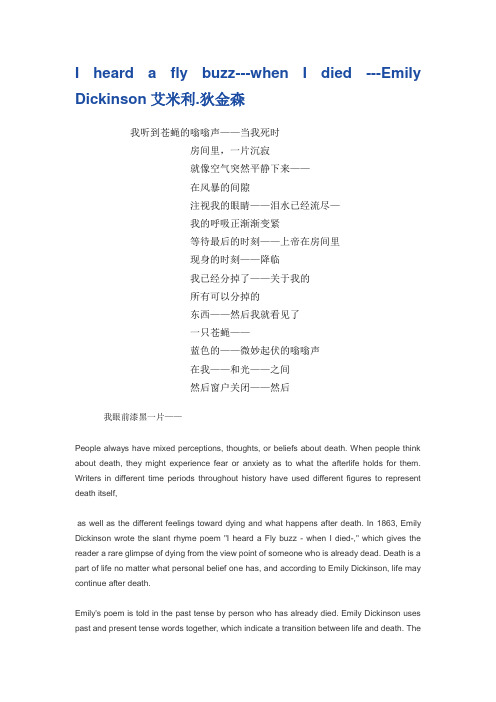
I heard a fly buzz---when I died ---Emily Dickinson艾米利.狄金森我听到苍蝇的嗡嗡声——当我死时房间里,一片沉寂就像空气突然平静下来——在风暴的间隙注视我的眼睛——泪水已经流尽—我的呼吸正渐渐变紧等待最后的时刻——上帝在房间里现身的时刻——降临我已经分掉了——关于我的所有可以分掉的东西——然后我就看见了一只苍蝇——蓝色的——微妙起伏的嗡嗡声在我——和光——之间然后窗户关闭——然后我眼前漆黑一片——People always have mixed perceptions, thoughts, or beliefs about death. When people think about death, they might experience fear or anxiety as to what the afterlife holds for them. Writers in different time periods throughout history have used different figures to represent death itself,as well as the different feelings toward dying and what happens after death. In 1863, Emily Dickinson wrote the slant rhyme poem "I heard a Fly buzz - when I died-," which gives the reader a rare glimpse of dying from the view point of someone who is already dead. Death is a part of life no matter what personal belief one has, and according to Emily Dickinson, life may continue after death.Emily's poem is told in the past tense by person who has already died. Emily Dickinson uses past and present tense words together, which indicate a transition between life and death. Thepoem is ironic and unique because there is a concern with a menial matter such as a buzzing fly at the final moment of life. In the first stanza the narrator states, "I heard a Fly buzz- when I died-". An annoying fly is usually not of utmost importance when one is dying. Death is perceived as a serious time in life. Emily Dickinson sets the tone of the poem intending to shock the reader, which is what happens.Analysis of I Heard a Fly Buzz When I died by Emily DickinsonIn Emily Dickinson's poem I Heard a Fly Buzz- When I Died, the feeling of death being present in the room is the overall tone. The tie in between death and the flies persistent buzzing is one that must be looked at very closely. The buzzing is not something that the average living person would notice but under the particular circumstances, even the smallest of details become noticeable as a man dies. As the voice in the poem is painting the picture of a funeral, the reader becomes more intoned to the idea of death through the use the figurative language and symbols when the voice speaks about the mourners who have gathered, the sound of a flies buzz, and the closing of the window.Within the poem Dickinson uses figurative language to her full advantage, using it to assist her in painting the picture of there being a sad moment in time successfully. The usage of the past tense when setting the scene where all the people were standing around grieving was done excellent through the choose of words. When using the word wrung it helps to suggest that the grieving is over for now, and it is now time to take control over their breathing and move on. Also when the voice is speaking of dieing, death is referred to signing away what he would have left to give of what at least be worth giving away.The usage, both placement and number of times used, of the flies buzzing was very critical itself with in the poem. If Dickinson were to use the symbol too much it would take away from the moment of focusing on death and cause people to think more about the fly. The flies buzz I fell is in the text because it is something a person would under a normal situation would ignore, but when you are dieing you become more in touch with your senses. The sense of hearing is the last one of the five senses a person will loose as the process of dieing comes to a closer, as in this poem.The idea of a window being closed is very symbolic in this poem, of a person's life coming to an end. When the window shuts it cuts off all the light to the person's eyes, and therefore the idea of death is being used. The window in this case may very well not even be a glass window a person would look out, yet instead the lid to the coffin this individual was lying in.Wither or not how Dickinson portrayal of death is realistic or not, she is able to achieve it through the grammatical chooses she makes. By the words she has chosen to use along with the modifiers there is only a couple of different ways to interpret this poem, but the idea of death would have to be in anyone interpretation. This poem made me feel almost a sense of grieving when I closed the books cover to the words.。
灰尘的旅行中的好词好句
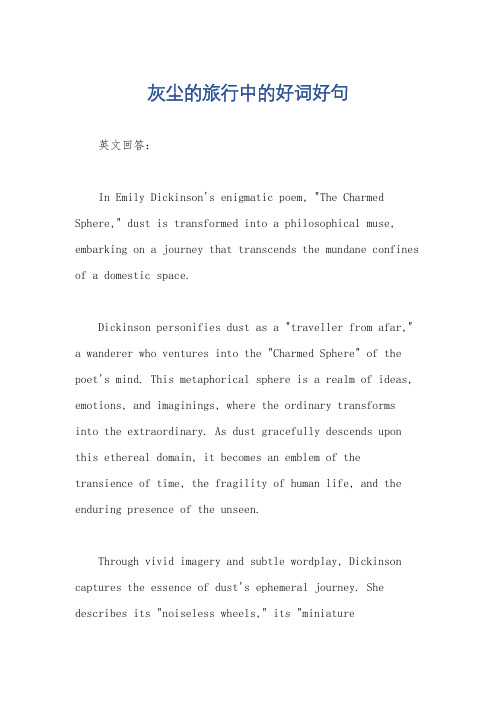
灰尘的旅行中的好词好句英文回答:In Emily Dickinson's enigmatic poem, "The Charmed Sphere," dust is transformed into a philosophical muse, embarking on a journey that transcends the mundane confines of a domestic space.Dickinson personifies dust as a "traveller from afar,"a wanderer who ventures into the "Charmed Sphere" of the poet's mind. This metaphorical sphere is a realm of ideas, emotions, and imaginings, where the ordinary transformsinto the extraordinary. As dust gracefully descends upon this ethereal domain, it becomes an emblem of the transience of time, the fragility of human life, and the enduring presence of the unseen.Through vivid imagery and subtle wordplay, Dickinson captures the essence of dust's ephemeral journey. She describes its "noiseless wheels," its "miniaturecommotion," and its "silken sound," suggesting a delicate and transient presence that is both alluring and elusive. The poem's language is rich with alliteration, assonance, and internal rhyme, creating a musicality that enhances the sense of dust's ethereal dance.Dickinson's use of paradoxical language further underscores the enigmatic nature of dust's journey. She refers to it as a "silent entertainment," hinting at its ability to evoke both wonder and contemplation. The "far country" from which dust originates remains unnamed,leaving readers to speculate on its cosmic origins or perhaps its connection to the realm of the spirit. Moreover, the poem's final line, "The Dust does not recount,"suggests that the true nature of dust's journey remains a mystery, an enigma that resists easy interpretation.In "The Charmed Sphere," Emily Dickinson invitesreaders to embark on a philosophical journey alongside dust, a seemingly insignificant yet profoundly symbolic entity. Through her evocative language and compelling imagery, she transforms dust into a vehicle for introspection, remindingus of the wonders that may be found in the most ordinary of places.中文回答:在艾米莉·狄金森那首神秘的诗歌《迷人的球体》中,尘埃被转化为一种哲学缪斯,它踏上了一段超越家庭空间世俗限制的旅程。
有关学校举行英文诗歌比赛的英语作文
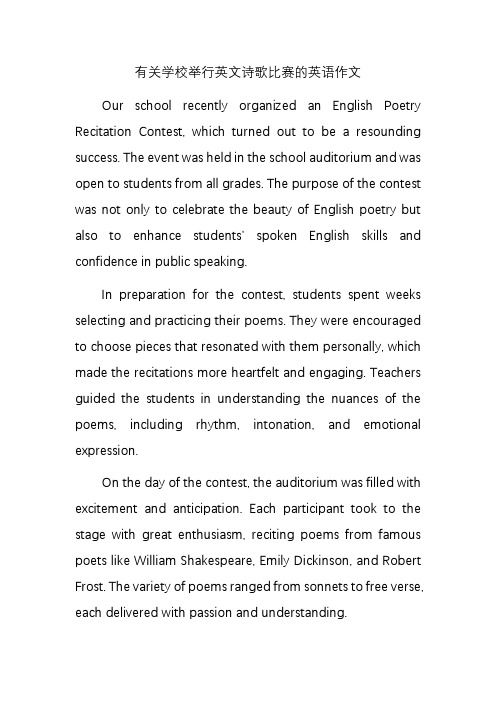
有关学校举行英文诗歌比赛的英语作文Our school recently organized an English Poetry Recitation Contest, which turned out to be a resounding success. The event was held in the school auditorium and was open to students from all grades. The purpose of the contest was not only to celebrate the beauty of English poetry but also to enhance students' spoken English skills and confidence in public speaking.In preparation for the contest, students spent weeks selecting and practicing their poems. They were encouraged to choose pieces that resonated with them personally, which made the recitations more heartfelt and engaging. Teachers guided the students in understanding the nuances of the poems, including rhythm, intonation, and emotional expression.On the day of the contest, the auditorium was filled with excitement and anticipation. Each participant took to the stage with great enthusiasm, reciting poems from famous poets like William Shakespeare, Emily Dickinson, and Robert Frost. The variety of poems ranged from sonnets to free verse, each delivered with passion and understanding.The judges, comprising English teachers and language experts, carefully evaluated each performance based on criteria such as clarity of pronunciation, interpretation of the poem, and overall presentation. The audience was captivated by the performances, often moved by the depth of emotion conveyed through the recitations.The contest concluded with the announcement of the winners, who were awarded with trophies and certificates. However, it was evident that every participant was a winner in their own right, having gained valuable experience and a deeper appreciation for the art of poetry.This event served as a wonderful platform for students to showcase their talent and further develop their language skills. It also fostered a love for literature and the English language among the students, which will undoubtedly benefit them in their academic pursuits and beyond.中文翻译:我们学校最近组织了一场英语诗歌朗诵比赛,结果大获成功。
emily dickinson关于生命主题的英文诗歌
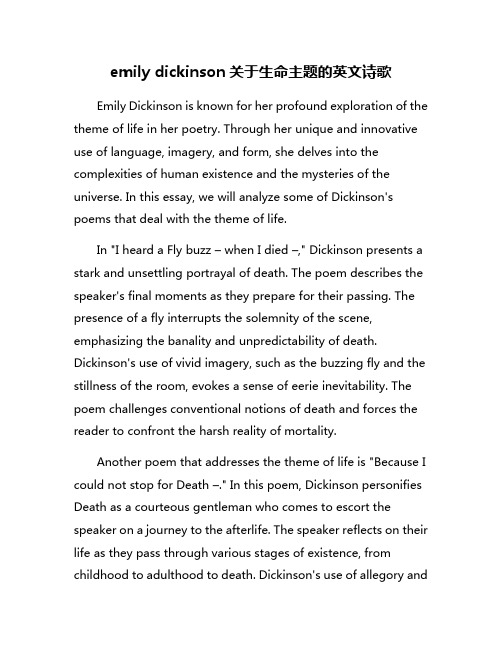
emily dickinson关于生命主题的英文诗歌Emily Dickinson is known for her profound exploration of the theme of life in her poetry. Through her unique and innovative use of language, imagery, and form, she delves into the complexities of human existence and the mysteries of the universe. In this essay, we will analyze some of Dickinson's poems that deal with the theme of life.In "I heard a Fly buzz – when I died –," Dickinson presents a stark and unsettling portrayal of death. The poem describes the speaker's final moments as they prepare for their passing. The presence of a fly interrupts the solemnity of the scene, emphasizing the banality and unpredictability of death. Dickinson's use of vivid imagery, such as the buzzing fly and the stillness of the room, evokes a sense of eerie inevitability. The poem challenges conventional notions of death and forces the reader to confront the harsh reality of mortality.Another poem that addresses the theme of life is "Because I could not stop for Death –." In this poem, Dickinson personifies Death as a courteous gentleman who comes to escort the speaker on a journey to the afterlife. The speaker reflects on their life as they pass through various stages of existence, from childhood to adulthood to death. Dickinson's use of allegory andsymbolism creates a dreamlike atmosphere that blurs the boundaries between life and death. The poem offers a meditative reflection on the passage of time and the cyclical nature of existence.In "I felt a Funeral, in my Brain," Dickinson vividly depicts the internal turmoil and psychological anguish of the speaker as they grapple with the concept of death. The funeral procession becomes a metaphor for the decay of the mind and the disintegration of the self. Dickinson's use ofstream-of-consciousness technique and fragmented imagery captures the chaotic and disorienting experience of mental breakdown. The poem is a powerful exploration of the fragility of the human psyche and the existential anxiety that accompanies the knowledge of one's mortality.Dickinson's poetry is characterized by its introspective and introspective nature, which reflects her own reclusive and introspective personality. Her poems often feature themes of death, loss, and the transient nature of life, reflecting her preoccupation with the mysteries of existence. Through her innovative use of language and imagery, Dickinson probes the depths of human experience and challenges readers to confront the profound questions of life and death. Her poetry continuesto resonate with readers today, offering insight into the complex and enigmatic nature of life.。
英美文学串讲7
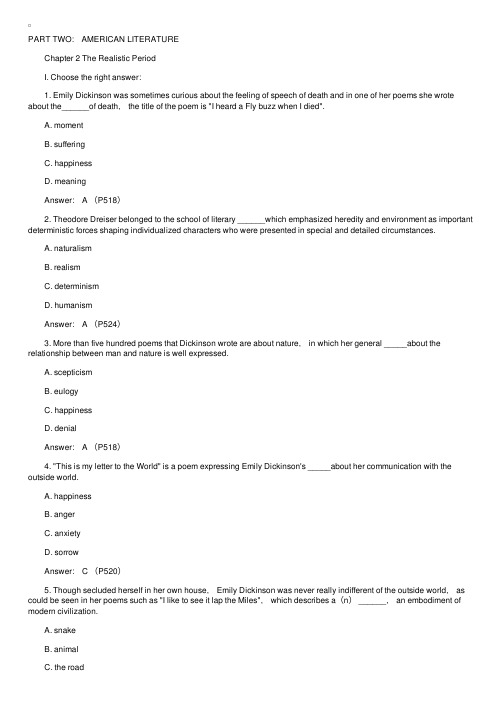
PART TWO: AMERICAN LITERATURE Chapter 2 The Realistic Period I. Choose the right answer: 1. Emily Dickinson was sometimes curious about the feeling of speech of death and in one of her poems she wrote about the______of death, the title of the poem is "I heard a Fly buzz when I died". A. moment B. suffering C. happiness D. meaning Answer: A (P518) 2. Theodore Dreiser belonged to the school of literary ______which emphasized heredity and environment as important deterministic forces shaping individualized characters who were presented in special and detailed circumstances. A. naturalism B. realism C. determinism D. humanism Answer: A (P524) 3. More than five hundred poems that Dickinson wrote are about nature, in which her general _____about the relationship between man and nature is well expressed. A. scepticism B. eulogy C. happiness D. denial Answer: A (P518) 4. "This is my letter to the World" is a poem expressing Emily Dickinson's _____about her communication with the outside world. A. happiness B. anger C. anxiety D. sorrow Answer: C (P520) 5. Though secluded herself in her own house, Emily Dickinson was never really indifferent of the outside world, as could be seen in her poems such as "I like to see it lap the Miles", which describes a(n) ______, an embodiment of modern civilization. A. snake B. animal C. the road D. train Answer: D (P521) 6. After "The Adventure of Tom Sawyer", Twain gives a literary independence to Tom's buddy Huck in a book called_____, and the book from which "all modern American literature comes". A. Life on the Mississippi River B. The Gilded Age C. Adventures of Huckleberry Finn D. The Sun Also Rises Answer: C (P479——480) 7. Winterbourne is used as a ______in Henry James's "Daisy Miller". A. Protagonist B. Narrator of the events C. A character of central consciousness D. Persona Answer: C (P499) 8. Emily Dickinson's verse is most aptly characterized as ___________. A. exposing the evils of the society B. paving the way for the following generation of free verse poets C. sharing the same poetic conventions as Walt Whitman D. exhibiting sensitiveness to the symbolic implications of experience, such as love, death, immortality and etc. Answer: D (P518) 9. The author of "The Portrait of a Lady" is best at_______. A. probing into the unsearched secret part of human life B. a truthful delineation of the motives, the impulses, the principles that shape the lives of actual men and women. C. a dramatizing the collisions between two very different cultural systems on an international scene D. disclosing the social injustices and evils of a civilized society after the Civil War. Answer: C (P496) 10. The period ranging from 1865 to 1914 has been referred to as _____________. A. the Age of Realism B. the Age of Modernism C. the Age of Romanticism D. the Age of Colonicalism Answer: A (P471) 11. Who exerts the simple most important influence on literary naturalism? A. Emerson B. Jack London C. Theodore Dreiser D. Darwin Answer: D (P475) 12. One of the most familiar themes in American naturalism is the theme of human "______". A. bestiality B. goodness C. compassion D. greed Answer: A (P476) 13. ______is considered by H.L. Mencken as "the true father of our national literature." A. Hemingway B. Poe C. Irving D. Twain Answer: D (P477) 14. Mark Twain wrote most of his literary works with a _______language. A. grand B. pompous C. simple D. vernacular Answer: D (P481) 15. Henry James's fame generally rests upon his novels and stories with________. A. international theme B. national theme C. European theme D. Regional theme Answer: A (P497) 16. In the following writers, who is generally regarded as the forerunner of the 20th century "Stream-of-consciousness" novels and the founder of psychological realism______________. A. Henry James B. Mark Twain C. Emily Dickenson D. Theodore Dreiser Answer: A (P498) 17. In Henry James' "Daisy Miller", the author tries to portray the young woman as an embodiment of ___________. A. the corruption of the newly rich B. the free spirit of the New World C. the decline of aristocracy D. the force of convention Answer: B (P499) 18. Which of the following is NOT a usual subject of poetic expression of Emily Dickinson's? A. War and peace B. Love and marriage C. Life and death D. Religion Answer: A (P517) 19. The following titles are all related to the subject that escapes from the society and returns to natureexcept__________. A. Dreiser's Sister Carrie B. Copper's Leather-Stocking Tales C. Thoreau's Walden D. Mark Twain's The Adventures of Huckleberry Finn Answer: A (P401 / P526) 20. The greatest work written by Theodore Dreiser is__________. A. Sister Carrie B. An American Tragedy C. The Financier D. The Titan Answer: B (P525) 21. Closely related to Emily Dickinson's religious poetry are her poems concerning ___________. A. Childhood B. Youth and happiness C. Loneliness D. Death and immortality Answer: D (518) 22. With Howells, James, and Mark Twain active on the literary scene, _________became the major trend in American literature in the seventies and eighties of the 19th century. A. sentimentalism B. romanticism C. realism D. naturalism Answer: C (P474) II. Read the quoted part and answer the questions: 1. "It was a close place. I took it up, and held it in my hand. I was a trembling, because I'd got to decide, forever,betwixt tow things, and I knowed it. I studied a minute, sort of holding my breath, and then says to my self: "All right, then, I'll go to hell"——and tore it up. It was awful thoughts, and awful words, but they was said. And I let them stay said; and never though no more about reforming." 1) Who was the "I", which book was the passage taken from? And by whom? 2) Why did he think "it was awful thought"? Analyze it. 3) Analyze the characteristic of the hero. Answer: 1) The character is Huckleberry Finn, the passage is taken from "Adventures of Huckleberry Finn" by Mark Twain.(P489) 2) It is the climax of the Huck's inner struggle on the Mississippi, when Huck is conflicting whether or not he should write a letter to tell Miss Watson where Jim is, and he is polarizing/contradicting by the two opposing forces between his heart and his head, between his affection for Jim and the laws of the society against those who help slaves escape. Huck's final decision -to follow his own good hearted moral impulse rather than conventional village morality. During his thinking Huck thinks of the consequence of helping Jim (the runaway slave), he might go to hell, "it was awful thought", with the eventual victory of his moral conscience over his social awareness, Huck grows. (P480) 3) Huck is an innocent and reluctant rebel, a typical American Boy with a "sound heart and deformed conscience". Through the eyes of Huck, the Pre-Civil War American society is fully exposed and we are deeply impressed by Mark Twain's thematic contrasts between innocence and experience, nature and culture, wildness and civilization. (P483) 2. "I should think it might be arranged," Winterbourne was thus emboldened to reply. "Couldn't you get some one to stay——for the afternoon——with Randolph?" Miss Miller looked at him a moment; and then with all serenity, "I wish you'd stay with him!" she said. Questions: 1) Please identify the work and the author. 2) Please analyze the character of Daisy Miller in literature. 参考答案: 1) It is taken from Henry James's "Daisy Miller". (P513) 2) She is the American Girl in Europe, a celebrated type who embodies the spirit of the New World. However,innocence, the keynote of her character, turns out to be an admiring but a dangerous quality and her defiance of social taboos in the Old World finally brings her to a disaster in the clash between two different cultures. (P499-500) 3. "We passed the School, where Children strove At Recess——in the Ring—— We passed the Fields of Gazing Grain—— We passed the Setting Sun——" Questions: 1) Please identify the poem and the poet; 2) What does "the School, the Fields of Gazing Grain and the Setting Sun" stands for? Answers:。
